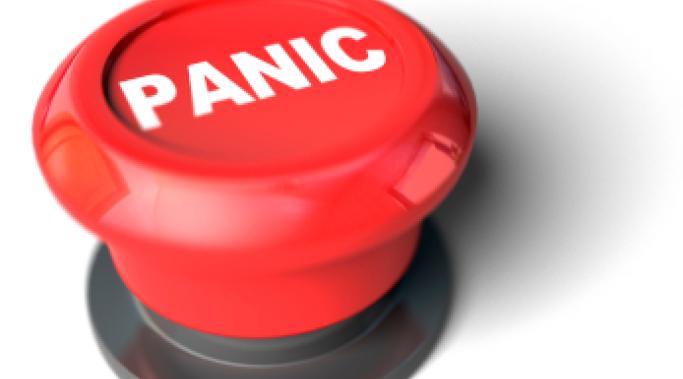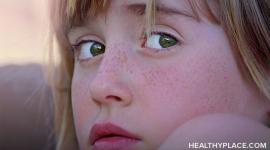Panic Disorder In Children And Adolescents

Detailed information on panic disorder in children and adolescents; including symptoms and treatments and how parents can help their children with anxiety and panic attacks.
What is panic disorder?
A child with panic disorder (PD) has sudden attacks of fear or severe anxiety. The fearful attacks happen several times over weeks or months. They may last a few minutes or they may last for hours. Attacks may happen for no obvious reason.
The attacks are not caused by fear of a single thing. That is called a phobia, like being scared of dogs or the dark. The attacks are also not caused by a traumatic event, like child abuse or being in a car accident. If caused by trauma, the child may have post-traumatic stress disorder.
All children and teens respond fearfully to the scary events of daily life. Their times of fear, however, are usually brief, and they go away without causing major problems. Panic disorder is when the fearful times happen over and over, begin suddenly without a clear cause, and are severe. PD interferes greatly with daily life at school and home.
How does it occur?
Panic disorder begins most often in the late teenage years into the mid-30s. It does, however, sometimes start in childhood. It begins with a few attacks that come and go. Often it never goes beyond this, but some children start having the attacks often.
A stressful event, like parents divorcing or a move to a new place, may trigger the beginning. But often PD begins with no identified stressful event. It is common for a child to have periods of time with attacks and then go weeks or months with few or none. What causes attacks to stop and return is often unclear.
Panic disorder runs in families. If a parent has panic disorder, children are more likely to have panic disorder, too. However, more than half of those with PD do not have a parent with a history of panic disorder. Children who were often scared when separated from their parents are more likely to develop PD later. Other than being hereditary, the causes of panic disorder are not certain.
What are the symptoms of panic disorder?
Panic attacks tend to come on suddenly. Children or teens with PD may:
- cry in fear
- tremble or shake
- be short of breath or feel like they are being smothered
- feel like they are being choked or have trouble swallowing
- sweat
- feel their heart pounding
- feel they are going to die or that they are going crazy
- feel very helpless to stop the attacks.
Along with these main symptoms, children or teens may:
- be on guard all the time or startle easily
- eat very little or become very picky eaters
- have trouble concentrating due to worry
- perform below their capabilities in school
- have frequent headaches or stomachaches
- have trouble falling or staying asleep, or have nightmares
- lose interest in activities they once enjoyed
- talk about death, such as saying "I wish I were dead."
Panic attacks often happen at certain times of day, such as bedtime, or with daily events, for example, going to school. When this is the case, the child often worries as these times approach. The child feels helpless to prevent the attacks.
How is panic disorder diagnosed?
Your child's health care provider or a mental health therapist can tell you if your child's symptoms are caused by panic disorder. A mental health therapist who specializes in working with children and teens may be best qualified to diagnose PD. The therapist will ask about your child's behavior and symptoms, medical and family history, and any medicines your child takes. Sometimes your child may need lab tests to rule out medical problems causing symptoms like stomachaches, trouble swallowing, or difficulties breathing.
Children and teens may have other problems or disorders in addition to PD, such as:
- attention deficit/hyperactivity disorder
- bipolar disorder
- general anxiety much of the time
- depression
- posttraumatic stress disorder
- obsessive-compulsive disorder
- substance abuse problems.
How is panic disorder treated?
Cognitive behavior therapy (CBT) helps children learn what causes them to feel panic and how to control it. CBT teaches specific skills for managing the fear and worrisome thoughts about whether an attack is coming.
Other behavioral therapies are also useful. Gradual exposure therapy teaches the child to stay relaxed while being exposed to situations associated with panic attacks.
Family therapy may also be helpful. Family therapy treats the whole family rather than just the child. Children often feel very supported when parents and siblings attend therapy with them and work as a group.
Medicines are sometimes needed when the symptoms are severe. Medicines may help reduce the frequency of attacks or how severe they are. Medicines used to treat PD in adults may not work best for children and young teens. It is important to have an experienced professional working with you and your child.
How long will the effects last?
Most children and teens can get over PD with good treatment and family support. Very often PD lasts for weeks or months and then disappears or reduces dramatically.
If a child has had PD once, then they are at greater risk for future PD. The mental health professional treating your child may recommend continuing treatment after your child begins to feel better. Symptoms may return since PD often comes and goes without a clear reason for stopping and starting.
What can I do to help my child deal with panic and anxiety?
It is very important to help your children feel supported and reassured.
- Reassure your children that their feelings are understandable and that they are not "going crazy." The support and understanding that you provide can help children deal with frightening emotions.
- Let your child talk about the scary feelings and fears of attacks if he or she feels ready. Do not force the issue if your child does not feel like sharing his or her thoughts
- Let your child make simple decisions when appropriate. Because PD often makes a child feel powerless, you can help by showing him or her that he or she has control over certain parts of his or her life. For example, you might consider letting your child decide how to spend the day, especially allowing him or her to pick places where they feel safest from attacks.
- Tell your child (repeatedly if necessary) that the attacks are not his or her fault.
- Stay in touch with teachers, babysitters, and other people who care for your child to share information about symptoms your child may be having.
- Do not criticize your child for acting younger than his or her age. If he or she wants to sleep with the lights on or take a favorite stuffed animal to bed, it's OK and can be soothing.
- Make sure your child gets enough sleep and exercise every day.
- Teach children and teens to avoid alcohol, caffeine, and stimulants like ephedra and guarana.
- Take care of yourself so that you are well equipped to help your child. You can't be supportive if you're neglecting your own emotional or physical health.
- If you suspect that your child is suicidal, get professional help immediately. Thoughts of suicide are serious at any age and require prompt attention.
When should I seek professional help?
When panic disorder seriously interferes with school, socializing with friends, or daily activities, your child needs help. If panic attacks happen more than a few times in a month, or if an attack is very severe, get professional help. The symptoms may not go away or may get worse without professional help.
Get emergency care if your child or teenager has ideas of suicide, harming him- or herself, or harming others.
Sources:
- NIMH - Anxiety
- American Psychiatric Association - Facts for Families, No. 50; Updated November 2004.
APA Reference
Staff, H.
(2022, January 17). Panic Disorder In Children And Adolescents, HealthyPlace. Retrieved
on 2025, November 26 from https://www.healthyplace.com/parenting/anxiety/panic-disorder-children-adolescents



